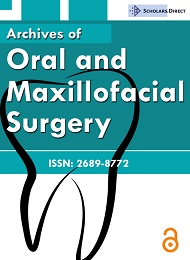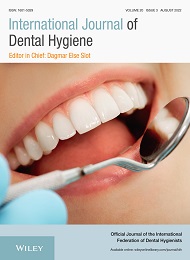Track 1: Current concepts in Oral Health
Dentistry continues to change, particularly because of the advances in clinical dentistry, materials and technology. These changes offer opportunities for both patients and dental practices alike. Now patients can benefit from the advances in Clinical dentistry and dental practices can benefit from the opportunity to move their business in a forward direction. Dental practices need to constantly look at the available options. Dentists can now offer patients advanced choices like Laser dentistry, dentistry, and Digital Implant dentistry.I find that dentists who are taking advanced clinical courses and utilizing technology are re-energized and enjoying dentistry more than ever before.
Track 2: Orthodontics
Orthodontics is that branch of dentistry involved with facial growth with the development of dentition and occlusion with the identification, interception, and treatment of occlusal anomalies. Orthodontics is the specialty of dentistry concerned with the growth and development of the face and dentition and the diagnosis, prevention, and correction of dental and facial irregularities. The word orthodontics comes from the Greek word ortho meaning straight and odons meaning tooth. Orthodontic treatment is often undertaken for the management of the disorder.
Track 3: Gerontology and Periodontology
Gerontology is the study of dentition and dental issues in older patients that involves the identification and treatment of dental injuries, diseases, or defects. The physiological, pathologic, and psychological changes in geriatric patients impact dental treatment. Periodontology deals with the study of supporting structures of teeth and connected diseases. The periodontium includes the animal tissue, alveolar bone, and solid body substance, and periodontics ligament. The invention of the microorganism that plays a crucial role in periodontal diseases and also the pathological process of the disease may be an advanced and complex topic.
Track 4: Dental Hygiene
Dental Hygiene is a method of caring the mouth and teeth clean to prevent dental problems, most commonly, gingivitis, dental cavities, bad breath, and periodontal (gum) diseases. Teeth cleaning mean the removal of dental plaque and tartar from teeth to prevent cavities, gum disease, gingivitis, and tooth decay. Poor hygiene of the mouth, particularly gum disease increases the risk of heart stroke, uncontrolled diabetes, and preterm labor. Vincent infection is a terrible disease of the mouth characterized by gray ulceration of the mucous membrane, bleeding of gums, foul odor to the breath, etc.
Track 5:Cosmetic Dentistry
Aesthetic enhancements to smiles through dental treatments are considered to be cosmetic dentistry. It is concerned with the function and appearance of the teeth. With more advancement in dentistry, cosmetic procedures range from correction of the basic color, to replacing missing teeth and everything in between. Dental technology’s latest advancements have allowed utilizing materials that are both durable and aesthetically pleasing to improve the appearance of common dental imperfections and restore both form and function of teeth. Cosmetic dentistry can improve the aesthetics of our teeth while helping us regain confidence in our smile.
Track 6: Oral Oncology
Oral cancer is cancer that develops in the mouth or throat tissues. Almost all cancers of the mouth occur in squamous cells, the type of cells that line the mouth, tongue, and lips. These are called squamous cell carcinomas (cancers). Not all tumors in the mouth are cancer. Some are benign and some are precancerous, meaning they may become cancer. Oral cancers are most often discovered after they have spread to the lymph nodes of the neck. Early detection is important for oral cancer survival. Tobacco use is one of the biggest risk factors for oral cancer. This includes smoking cigarettes, cigars, and pipes, as well as chewing tobacco. The survival rate after one year for all stages of oral cancer is 81%. After five years, the survival rate is 56%, and after 10 years it’s 41%. The removal of tumors of large size could possibly affect your abilities associated with the jaw and mouth such as chewing, swallowing, or talking.
Track 7: Pediatric Dentistry and Dental Nursing
Pediatric dentistry is a sub-branch of dental science that provides initial oral health cares for infants and children till adolescence. During the first 6 months of life, children begin to get their baby teeth. After that, they start to lose their first set of teeth which will be replaced by secondary (permanent) teeth. Without proper dental care, they face oral decays and diseases that can cause complications and pain. Early childhood dental caries is 10 times more common than other diseases.
The critical part that dental practitioners, dental hygienists, researchers, and other well-being experts of dental occasions will prompt the sheltered and powerful ailment anticipation measures to exist that everybody can embrace to enhance oral well-being and avert sickness. Oral issues, including dental and periodontal contaminations, dry mouth, and tooth rot, are for the most part treatable with legitimate findings and care.
Track 8: Innovations in Dentistry
Increased interest in dental health associated with new products and new players in the dental market constantly lead to tackling dental health with more speed and precision. Over the last decade, the dental industry has experienced a massive influx of new technologies. The advances in the dental stream have resulted in a streamlined workflow, restorative dentistry accuracy as well as elevated product consistency. By developing new practice models these technologies will continue to advance and require adaptation that enables "mission critical" technologies to remain affordable.
Track 9: Dental Instruments and Dental Marketing
Dental Instruments are the equipment that is used to fix dental problems and injuries. There is a wide range of dental instruments which are employed for the repair and fixture of the teeth. Dental marketing can be defined as the branch of dentistry that deals with the marketing of the various dental instruments and equipment which are used to repair dental injuries. Dental marketing includes the various groups of people who are involved in the manufacture of dental instruments and dentists who run a clinic.
Track 10: Odontology
Odontology is the branch of dentistry that involves the application of dental science to the identification of unknown human remains and bite marks, using both physical and biological dental evidence. Forensic Odontology is the emerging branch of odontology defined as the application of dental expertise to the legal system. Forensic odontology has a wide scope in the identification of the unknown decedents by the teeth, jaws, and craniofacial bones bite mark identification, analysis of the Oro-facial trauma associated with personal abuse, dental jurisprudence including expert witness testimony. Forensic dental services are of value both in death investigations and in clinical forensic medicine for the evaluation of living victims of sexual assault, child abuse, and other domestic violence.
Track 11: Oral and Maxillofacial Surgery
Oral and maxillofacial surgery is the specialty of dentistry, which includes revising an extensive variety of wounds, ailments, and deformities in the head, face, neck, and tissues in the oral and maxillofacial area. It encompasses the diagnosis and treatment of diseases, traumatic injuries, and deformities of the face, mouth, dentition, jaws, and neck. It also includes the diagnosis and surgical treatment of diseases, injuries, and defects of tissues (both hard and soft) of the oral and maxillofacial region.
It is a bridge between medicine and dentistry, treating conditions that require expertise from both backgrounds such as head and neck cancers, early dental implant failure, antibiotic prophylaxis, salivary gland diseases, facial disproportion, facial pain, and cysts and tumors of the jaws and infections. It provides the highest standard of surgical care for patients with benign and malignant tumors of the head and neck region, the trauma of the oral and maxillofacial region, basic oral surgical procedures including removal of wisdom teeth and the placement of implants, and dentofacial and cleft deformities.
Track 12: Dental Biomaterials
Dental biomaterials are specialized instruments that are designed to be used in dentistry. These are fabricated structures. Their main focus is the replacement and enhancement of missing tissues due to some disease or accidents and also to restore their normal function. Dental biomaterials professionals study the structure, properties, and processing of these materials and the interaction of these materials with the face and mouth tissues. It is principally involved in restorative dentistry, prosthodontics, pedodontics, and orthodontics. The dental materials are designed with the key components of every dental procedure. The use of these materials depends largely the on the type of practice operated. New dental materials are introduced in the market at a rapid pace, so staying on top of our options is an ongoing part of practicing dentistry.
Track 13:Orthodontics and Endodontics
Orthodontics is a practice of dentistry that deals with the correction of irregularities in the teeth by means of braces. It also deals with the diagnosis and treatment of dental deformities of the upper to lower jaw. Endodontics is a dental specialty that deals with the cause, diagnosis, prevention, and treatment of dental pulp and its replacement with filling materials, and pulp canal therapy.
Track 14: Dental Sleep Medicine and Obstructive Sleep Apnea
Dental sleep medicine focuses on the use of oral appliances to treat sleep-disordered breathing, including snoring and obstructive sleep apnea (OSA). These customized sleep apnea oral appliances are made by dentists using a plastic-like mold according to the specific shape of the patient’s mouth and teeth. They not only work against sleep apnea but also effectively stop snoring. Sleep apnea is a potentially serious disorder in which breathing starts and stops repeatedly.
Track 15: Dental Anesthesiology and Pain Management
The dental Anesthesiology we used earlier is nitrogen oxide and ether to control the pain of the tooth. This allows millions of patients to undergo painless surgery, but not all.Dental Anesthesiology includes.
Local Anesthesia: The most local anesthesia is lidocaine. Its half-life in the body is about 1.5 to 2hrs. This controls bleeding in the tissue during procedures
Maxillary Anesthesia: Local anesthesia is deposited at the buccal (cheek) side of the maxillary alveolus which can diffuse through the thin cortical plate of the maxilla, then further into the pulp of the tooth in order to get dental anesthesia effect.
Mandibular Anesthesia: The technique to be used is chosen based on the patient’s age and the tooth to be anesthetized. A regional block or Infiltration technique is used here
Oral surgeons specialists (oral surgeons, endodontists, orthodontists, periodontitis, and pediatric dentists), oral surgeons are consistently the highest earning oral surgeons specialists while periodontitis are the lowest earning oral surgeons specialists.
Among the five specialist types studied in this brief, orthodontists have the lowest self-reported busyness levels while oral surgeons have the highest self-reported busyness levels.
Among the five specialist types studied in this brief, a greater percentage of pediatric dentists work in oral surgeon’s service organization (DSO) affiliated practices while a lower percentage of periodontists work in DSO affiliated practices
Oral and maxillofacial pathology getting to be distinctly essential to all the world oral surgeons’ specialists. Oral and maxillofacial surgery is considered as private segment treatment in Italy, as just 4% of oral surgeons care is given inside the NHS. As indicated by a recent report (Servizio Study ANDI) in view of ISTAT information, 39.7% Italians went to a oral surgeons specialist at any rate once per year, contrasted with 11.5% who never went by. Private oral surgeons’ consumption was evaluated in 2013 to be about €10 billion. It has been assessed that Oral surgeon’s administrations in Italy are given through a system of 56,000 oral surgeons’ practitioners and business research centers are dynamic, with 11,520 oral surgeons’ professionals working either as proprietors or representatives. In Italy, most oral surgeons’ practitioners who hone all alone or as little gatherings, outside healing centers or schools, and give an expansive scope of general medications are said to be in "Private Practice”. It additionally gives the opportunity to analysts, experts and instructors to introduce and talk about the latest advancements, patterns, and concerns, reasonable difficulties encountered and the solutions adopted in the fields of Oral Health & Maxillofacial Surgery.


